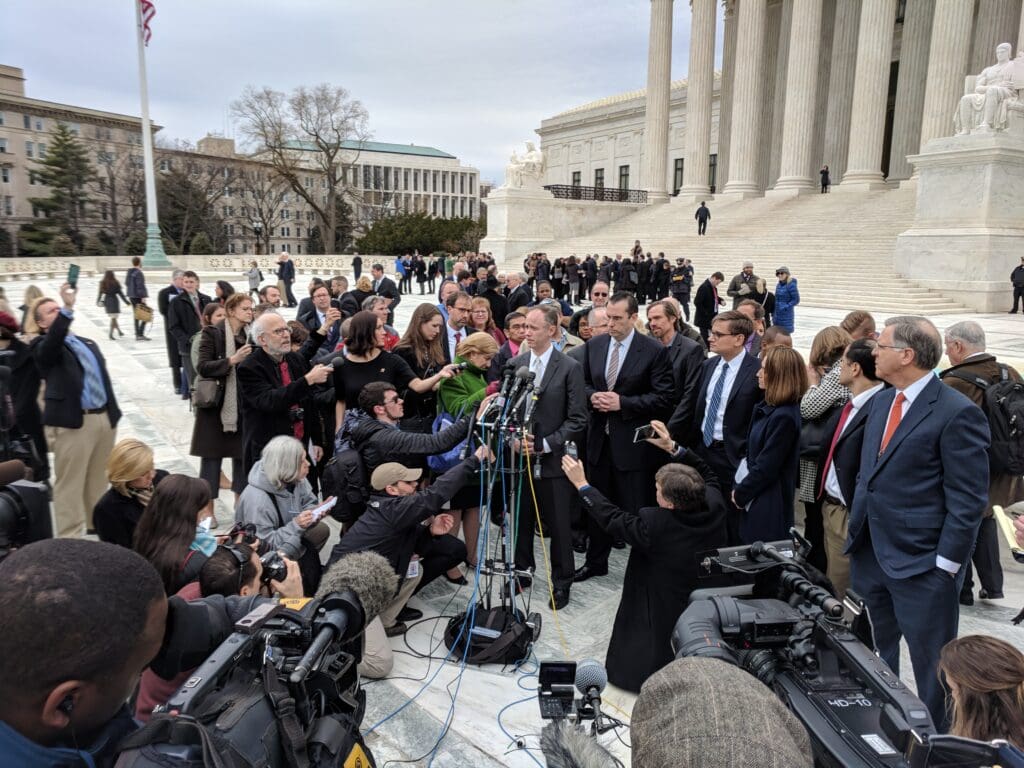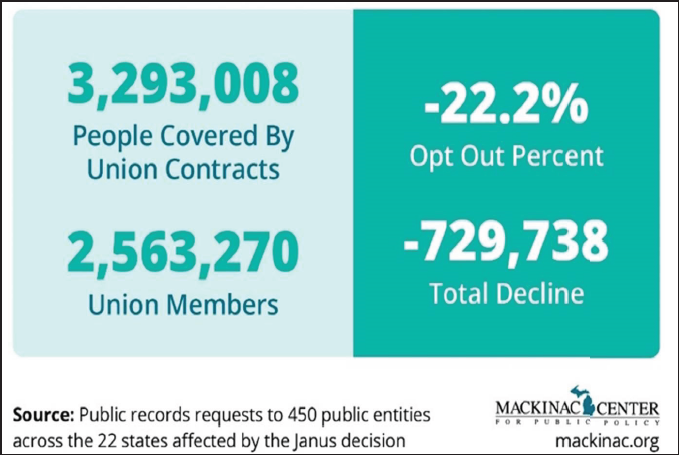
Right to Work Expansion Hitting Union Coffers
But Public Union Bosses Still Inflicting Massive Harm on U.S.A.
Until just over five years ago, the overwhelming majority of America’s nearly seven million unionized state and local public employees still resided in jurisdictions where they had no Right to Work protections.
But on June 27, 2018, the U.S. Supreme Court handed down what is arguably the most dramatic expansion of employees’ freedom of association in the last century with its Janus v. AFSCME decision.
In Janus, a case argued and won by then-National Right to Work Legal Defense Foundation staff attorney and current Foundation Vice President Bill Messenger, the High Court decided that public employers across the country may not fire civil servants for refusing to pay union dues or fees.
Mr. Messenger argued this case free of charge, all the way to the Supreme Court, on behalf of independent-minded Illinois civil servant Mark Janus.
In addition to Mr. Messenger and several other Foundation attorneys, attorneys for the nonprofit Liberty Justice Center in Chicago furnished Mr. Janus with free legal aid.
Data Show Big Labor Failed To Turn Forced Support Into Voluntary Support
At the time Janus was announced, 27 states already had laws on the books prohibiting compulsory support for all, or at least most, government union bosses.
(One other state, Missouri, also had a Right to Work law, but Big Labor had successfully blocked its implementation, and was soon to wipe it off the books.)
Nevertheless, pre-Janus, roughly 5.6 million, or 80%, of America’s unionized state and local public servants lived in places where they could be forced to bankroll a union on pain of termination.
In early 2018, some Organized Labor observers recognized that a pro-free speech Janus ruling could potentially mean an annual loss of hundreds of millions or even billions of dollars in coerced union dues and fees for government union bosses.
To avoid major financial setbacks, Big Labor knew it would have to persuade, by hook or by crook, vast numbers of workers to support unions voluntarily who, before Janus, were only forking over union dues or fees because they had to in order to keep their jobs.
Assessing just how successful or unsuccessful union bosses have been in stemming their losses of dues- and feepayers and revenue since 2018 is not easy for several reasons.
Unlike all private-sector unions with annual revenues exceeding $250,000, government unions with no private-sector members do not have to file annual LM-2 forms reporting their membership totals and revenue sources.
Even among the government unions that do have at least a handful of private-sector members and consequently must file LM-2s, there is no requirement to use consistent criteria from year to year regarding who constitutes an “active member” of the organization.
Fortunately, there is a resource that is far superior to LM-2 forms for assessing the impact of Janus on government union membership: State and local government payroll departments in all 50 states record how many employees are subject to “exclusive” representation during any given pay period, and how many are having dues withheld from their paychecks.
Public-employee payroll records are not published, but interested persons may obtain them by filing freedom-of-information (FOIA) requests under state government transparency laws.
And over the course of the five years since Janus, the Midland, Mich.-based Mackinac Center for Public Policy (MCPP) has submitted FOIA requests to public employers in every non-Right to Work state except Missouri to ascertain how many employees have successfully opted out of union financial support.
The data the MCPP has obtained include nearly 60% of the roughly 5.6 million “public workers employed in unionized workplaces” just prior to Janus in the 22 states the group has been tracking.
As of 2022, the MCPP was able to obtain employment records for 3.293 million government employees working under union monopoly-bargaining deals in public workplaces in the non-Right to Work states it is tracking.
Without Janus, virtually all of these employees would still be bankrolling a union to keep their jobs. But the data show that, thanks to Janus, nearly 730,000 of them are not having any union dues withheld from their paychecks.
Number of Civil Servants Who Pay Money to a Union Down By Roughly 1.2 Million
Based on the large sample for which it was able to obtain data, the MCPP estimates there are 1.2 million fewer actively employed civil servants bankrolling a government union today than there would be had the Janus case never made it to the Supreme Court, or had the court ruled the other way.
While annual union dues assessments per worker vary widely and there is no easy way to estimate the average for public employees nationwide, if one assumes it is $600, as the MCPP very conservatively does, that means Janus is now costing Big Labor roughly $720 million in revenue every year.
Moreover, the experiences of Wisconsin and Michigan, which respectively afforded Right to Work protections to public educators and a range of other public servants in 2011 and 2013, union bosses’ dues-money losses related to Janus are likely to continue growing for years to come.
Many Workers Reasonably Believe Big Labor Work Rules Prevent Them From Excelling
Why would a public servant choose not to support financially the union that wields monopoly power to deal directly with his or her employer on matters of pay, benefits, and work rules, once the employee has a free choice about that?
National Right to Work Committee President Mark Mix commented:
“No two independent-minded employees would offer exactly the same answer, but the answers commonly fall into one of a few categories.
“For example, many public employees have solid grounds for believing that Big Labor work rules hinder them from performing their jobs to the best of their ability.”
Mr. Mix highlighted a recent commentary for the Wall Street Journal by Success Academy Charter Schools founder and CEO Eve Moskowitz. Ms. Moskowitz called New York City teacher union bosses to account for blocking the introduction in schools they control of reading programs that require a wide range of educators, from assistant principals to art instructors, to help kids learn to read.
Since 2006, the Success Academy has demonstrated that poor and minority school children can outperform the New York State average for all schoolchildren in reading and other key subject areas when education employees of all types work together to help them learn to read.
But up to now, American Federation of Teachers (AFT)-affiliated union bosses have made it impossible for district public schools to adopt a similar or identical reading-instruction program.
Union Bosses Refused to Lift A Finger to Help Teachers Shield Their Religious Liberty
Another reason many public employees choose not to bankroll a union, noted Mr. Mix, is that union officials refuse to stand up for rights that are important to those employees.
A case filed this May in the Rhode Island Superior Court by teachers who were fired for exercising their religious freedom not to receive a COVID-19 vaccine offers a good illustration, he said:
“Whatever one thinks of mandatory vaccines generally, there was never a remotely plausible case for forcing public educators to get a COVID-19 vaccine to stay on the job.
“The fact is, by late summer 2020 there was already compelling evidence that COVID-19 poses very little risk to the health of school-aged children, and teachers are not at elevated risk of falling seriously ill.
“At the time Rhode Island teachers Brittany DiOrio, Stephanie Hines, and Kerri Thurber invoked their constitutional freedom of religion as grounds for their refusal to get vaccinated, they were all dues-paying members of their National Education Association [NEA]-affiliated teacher unions.
“Yet teacher union bosses who relentlessly boast about how they supposedly defend the interests of members refused to lift a finger to help them.
“The only reason the teachers were ultimately able to get fully reinstated and receive back pay is because of a settlement won on their behalf by a private attorney they had engaged.”
Post-Janus, Government Union Bosses Retain Extraordinary Monopoly-Bargaining Privileges

The most plausible explanation for why teacher union bosses threw Ms. DiOrio, Ms. Hines, and Ms. Thurber under the bus is that, post-Janus, cultivating a sense of hysteria about COVID-19 has been one of union bosses’ most effective ways of securing new sources of revenue.
Most significantly, union bosses were able to leverage the school lockdowns that continued throughout most of the 2020-21 academic year, for no fathomable medical reason, to rake in roughly $200 billion in federal “stimulus” money funneled to government schools by a Big Labor Congress in March 2021.
The fact that top teacher union bosses like the AFT’s Randi Weingarten were able to exploit the ample union monopoly-bargaining privileges that Janus left untouched to pull off this unprecedented coup shows that much more remains to be done to check the still-inordinate clout of Big Labor.
This article was originally published in our monthly newsletter. Go here to access previous newsletter posts.
If you have questions about whether union officials are violating your rights, contact the Foundation for free help. To take action by supporting us and fueling the fight against Forced Unionism, click here to donate now.
